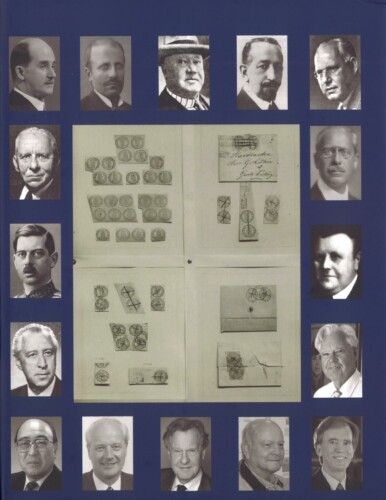
There are publications where one does not know what to admire more: The depth and scope of the research and documentation, the content of the information offered for the first time in such profusion, or else the combined aspects of significant philatelic and literary facts. This new 500-page work, published by the Royal Philatelic Society London, combines all this and much more in a book that goes far beyond previous studies of this kind to offer a unique presentation of all the known Tête-Bêches of the first issues of Finland.
These reverse pairs have always been very popular, especially with well-known collectors. From 3 March 1856, the first issue of 5 kopecks in blue and 10 kopecks in pink appeared in Finland in small quantities in an oval design whose simple production resulted in reverse printing positions. Two years later, on 8 March 1858, a new 5 kopek was issued. The design was the same as before, except for the size of the pearls in the post horns, which were now longer. The stamps were printed in a primitive way, as the printing press, a very simple lever machine attached to a wooden table in a room at the Ministry of Finance in Helsinki, could only print a row of ten stamps at a time. The prepared paper could hold 140 impressions and was therefore divided into seven parts. One row of ten stamps was printed, the paper was turned over and then a second row was printed. Thus, each sheet of twenties consisted of ten tête-bêche pairs.
Among notable collectors since the time of a Sir Daniel Cooper or Marcellus Purnell Castle in the 19th century, these issues and reverse prints have attracted just as much attention over the past 100 years, e.g. Maurice Burrus, Rolf Gummesson, Hiroyuki Kanai, Luis Alemany Indarte or Gustav Douglas. In 1956, L. Linder described their history in his book “Finlands Ovalmärken”, as far as it was known to him at that time, before him Pierre Grosfils-Berger in 1947, followed by Juhani Olamo in 1985 and last but not least Leon Norman Williams in 1997, who in his book “Encyclopaedia of Rare and Famous Stamps” (Volume 2: The Biographies) was able to offer 33 pages of provenance documentation and black and white illustrations of the individual pieces that were available to him at that time.
Bjäringer/Sundberg approach their project differently. They not only take into account the pieces that were included in well-known special collections – owners’ names have already been mentioned – they also focus on the philatelists who, unlike Ferrari, Duveen, Lichtenstein, Hind, Lagerloef, Carol II, Caspary, Champion, Amundson and Gross (they all also owned extraordinary rarities of these issues!) are less or hardly known or – as they write – “have left no traces in the philatelic world”. The result is probably today’s most complete listing of all known tête-bêche prints, to each of which the provenances and a bibliographical listing of all known publications to date are assigned. This was made possible primarily by one of the best philatelic libraries that Tomas Bjäringer calls his own. For decades he has been searching the world for auction catalogues and other publications, for (colour!) photos and specimens that have not yet been known or printed. In doing so, both authors prove themselves to be up to date, as even the numerous footnotes show.
This is a book that cannot be bettered and it is likely to be the benchmark on the subject for a long, very long time. In other respects, too, for Tomas Bjäringer is very individual as a bibliophile. Back in 1986 he surprised everyone by co-authoring Jan Billgren / Tomas Bjaeringer / L. H. Stone: “Swedish Letter Rates to Foreign Destinations 1855-1895”, a standard work in large format with 235 pages, gilt edges, leather binding with gilt spine embossing and a bibliophilically designed slipcase. The work, which is very rare today, was published in a limited edition of only 200 copies. Bjäringer has gone one better with his new book: it was only printed in 100 + 12 (!) copies, 100 of which were offered in advance by subscription. Within six weeks, the luxury book (leather hardcover with gold title and spine embossing, pages with gold edges all around, with dust jacket and specially handmade leather slipcase with gold title embossing!), which costs almost 400 euros including customs + shipping from England, was sold out!
It may be due to the well-known tradition of A. M. Tracey Woodward’s book “The Postage Stamps of Japan and Dependencies” (Japan, 1928) that Bjäringer – supported and probably initiated by Jonas Hällström – had another idea, namely to have a special edition of this luxury book produced for review purposes in an edition of only 30 copies. This edition differs from the “original” (it lacks the gilt edges, leather binding and slipcase, only a normal hardcover), but the contents are almost identical (with the label “Review Edition No. … / The Publications Committee / Jonas Hällström / Chairman”). Nevertheless: Woodward’s “Review Copy”, also differently printed on normal instead of handmade paper, was recently sold at Corinphila Veilingen in Amstelveen in September 2023 for 3,800 euros! As said before: this book is something very special in every respect and one can only congratulate the authors.


